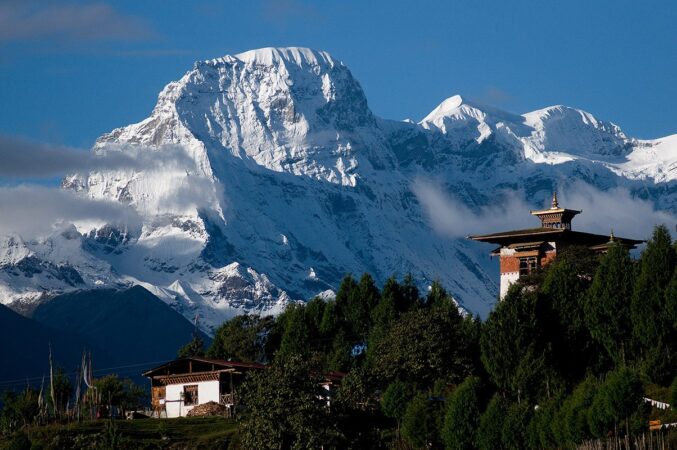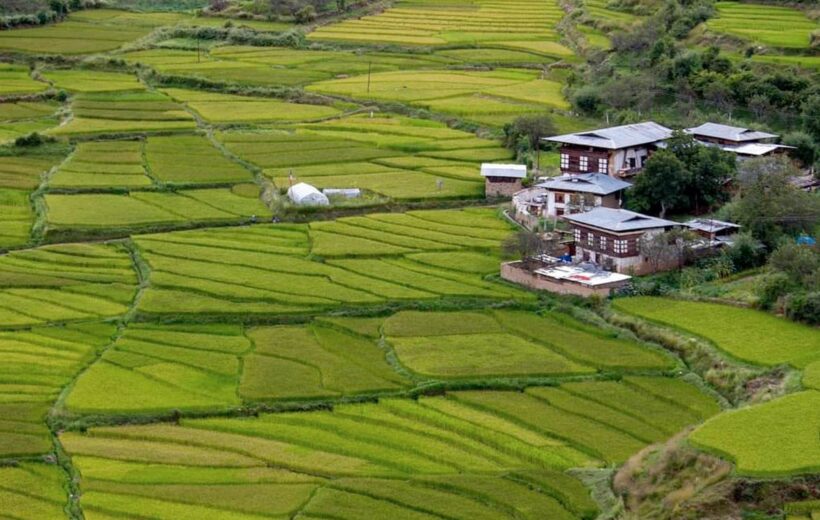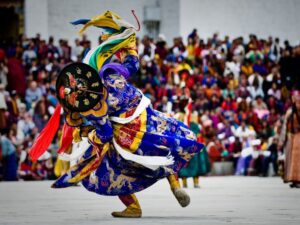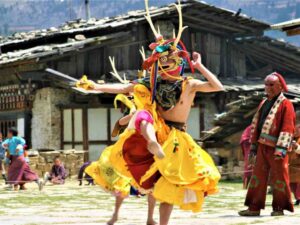Overview
Join World Perfect Tours for an extraordinary 13-day trek that spans serene valleys, ancient monasteries, and mountain vistas in Bhutan. Starting in Paro and ending in Thimphu, this trek takes you through remote villages and untouched wilderness. Discover the sacred lakes of Labatamba, fish in tranquil waters, and experience Bhutan’s unique blend of culture and nature on this immersive journey through its stunning landscapes.
Included/Excluded
- The Bhutan SDF
- All accommodations
- Meals and mineral water
- A licensed English-speaking guide
- A driver and vehicle
- Air fare
- A visa fee of US $40
- Alcohol
- Gifts/Souvenirs
- Travel insurance and personal bills
- Museums & Monument Fees
Tour Plan
Day 1: Arrival in Paro
Upon landing at Paro International Airport, meet your guide and transfer to your hotel. Take time to relax or explore the town’s vibrant market streets and soak in the local atmosphere. Overnight in Paro.
Day 2: Paro Sightseeing
Today, drive to the ancient ruins of Drukgyel Dzong, built in 1646 to defend against Tibetan invaders. Despite being partially destroyed by fire, the fortress still impresses visitors with its commanding views, including a stunning glimpse of Mount Jomolhari on clear days. Visit the sacred Kyichu Lhakhang temple and a traditional Bhutanese farmhouse. In the afternoon, tour the National Museum at Ta Dzong and descend to Rinpung Dzong, the administrative and monastic center of Paro. Overnight in Paro.
Day 3: Journey from Paro to Thimphu (55 km, 2 hours)
Depart Paro and follow the Paro River as it merges with the Wang Chu. En route, stop by Simtokha Dzong, the oldest fortress in Bhutan, now serving as the Institute for Language and Culture Studies. Upon arrival in Thimphu, visit the National Memorial Chorten, dedicated to Bhutan's third king, and the impressive Tashichhodzong, home to government offices and the monastic body. In the evening, explore Thimphu’s lively markets. Overnight in Thimphu.
Day 4: Discovering Thimphu
Explore the cultural and historical treasures of Bhutan’s capital. Visit the National Library, housing sacred Buddhist texts, and the Institute for Zorig Chusum, where traditional arts and crafts are taught. Stop by the Folk Heritage Museum, the National Textile Museum, and browse local handicrafts. In the evening, drive to a panoramic viewpoint overlooking the Thimphu valley. Overnight in Thimphu.
Day 5: Trek to Genekha
Begin your trekking adventure with a short drive to the trailhead. Pass through terraced farms and lush forests before arriving in Genekha village. Set up camp by a stream at 2,800 meters.
Day 6: Genekha to Gur (15 km, 4 hours)
Trek through a landscape dotted with alpine plants and wildlife. Ascend to a large rock platform offering sweeping views of the valley, then continue to the remote campsite of Gur, surrounded by blooming wildflowers.
Day 7: Gur to Labatamba (12 km, 5 hours)
Cross high ridges and walk through meadows filled with mountain flowers. After a hearty lunch at a yak herder’s camp, reach Yutsho Lake, renowned for its golden trout. Camp near the lake.
Day 8: Rest Day in Labatamba
Spend the day exploring the sacred lakes of the region, including Relitsho, Hentsho, and Jamatsho. Enjoy trout fishing in the peaceful surroundings. Overnight at Labatamba.
Day 9: Another Day at Labatamba
Hike to Setsho Lake and, for the more adventurous, continue to the remote Jagetsho Lake. You can also attempt the challenging climb to Jomo Peak, offering panoramic views from 5,050 meters. Return to camp by evening.
Day 10: Labatama to Panka (8 km, 4 hours)
Begin the day with a short ascent to a high pass at 4,460 meters before descending into the green meadows of Panka. Keep an eye out for rare Himalayan pheasants along the way. Camp at Panka.
Day 11: Panka to Talekha (8 km, 4 hours)
Cross several mountain passes, each offering more stunning views of the Himalayas. During the summer months, the trail is alive with blooming blue poppies. Camp near Talekha Monastery.
Day 12: Talekha to Thimphu and Drive to Paro (6 km, 2 hours)
Trek downhill through bamboo forests and lush meadows before reaching the main road to Thimphu. Enjoy lunch in Thimphu before driving back to Paro for a final night in this charming town.
Day 13: Departure from Paro
Conclude your Bhutanese adventure with an early morning drive to Paro Airport for your onward journey.
Tour Map
Frequently Asked Questions
Bhutan is a year-round destination. There are four seasons: summer (June to August), autumn (September to November), winter (December to February) and spring (March to May). But because of the range of altitudes in the country, and the influence of the north Indian monsoons, the climate is incredibly varied.
In the south, the humid, subtropical climate is fairly consistent year-round, with temperatures between 15oC and 30oC. Central Bhutan, with its temperate forests, has a more seasonal climate, with warm summers and cool, dry winters. The northern regions are much colder during winter. Because of the high altitude, mountain peaks are snowy year-round and the lower reaches remain cool in summer.
In summer, the Indian monsoon season runs from late June or July to late September, mostly affecting the southern regions. Most farming activities take place in the summer, when crops thrive in verdant landscapes.
Autumn, from late September or early October to late November, follows the rainy season. It is characterised by bright, sunny days and some early snowfall at higher elevations. It’s the season of feasts and festivals as farmers reap the fruits of their work.
From late November until March, the crisp, clear and sunny winter sets in, with frost throughout much of the country and snowfall common above elevations of 3,000 metres. The winter northeast monsoon brings gale-force winds at the highest altitudes through high mountain passes, giving Bhutan the name Drukyul, which means Land of the Thunder Dragon in Dzongkha (Bhutan’s national language).
Bhutan’s generally dry spring starts in early March and lasts until mid-April. It is a botanist’s delight, with nature in full bloom. Summer weather commences in mid-April with occasional showers and continues to late June.
Visitors of all nationalities, except those from India, require a visa before entering Bhutan. For all visitors, except those from Bangladesh and the Maldives, this visa must be applied for and approved in advance of travel. Visitors from Bangladesh and the Maldives also require a visa, but this can be applied for and approved either in advance of travel or upon arrival in Bhutan.
Visitors from India are able to apply for a permit but are required to hold an Indian passport or an Indian voter ID card. For Indian nationals under the age of 18, a passport or a birth certificate can be used to enter and they must be accompanied by a legal guardian.
Nationals from Switzerland and Thailand holding diplomatic or government-official passports are eligible for a visa at their port of entry.
A correctly input visa application can take up to five days to process.
There is a one-off fee of US$40 for the processing of your application. This is payable at the same time as your Sustainable Development Fee (SDF), as part of the process of submitting your visa application.
All treks must be undertaken with an accredited tour operator or guide. Your tour operator will assist you with all the necessary logistics and safety precautions.
Please contact our hosts for the Department of Tourism’s list of approved tourism services.
The Sustainable Development Fee (SDF) is a daily levy paid by visitors to support Bhutan’s development. Since the kingdom first opened its doors in 1974, guests have played a critical role in our country’s growth.
The SDF is collected by the national exchequer and funds are allocated to various projects that create long-term, sustainable opportunities for the Bhutanese people, through free healthcare, education and training, upskilling the tourism and hospitality industry, improved infrastructure, environmental preservation and conservation, cultural preservation programmes and initiatives that support local businesses and economies. The SDF is also a vital means of maintaining the exceptional forest cover and carbon-neutrality for which our small nation is world-renowned and globally critical. The SDF also helps us to ensure that we can continue to offer guests tranquillity and an intimate experience.
The SDF is USD 100 per night for adults from all countries except for India. Children aged between 6 years and who have not yet turned 12 are eligible to pay USD 50 per night. Children who have not yet turned 6 years old do not have to pay any SDF.
The SDF for Indian nationals (showing a valid Indian passport or Voter ID card) is Nu. 1,200 (or the equivalent amount in Indian rupees) per person, per night. Children aged between 6 years and who have not yet turned 12 are eligible to pay Nu./INR 600 per night. Children who have not yet turned 6 years old do not have to pay any SDF.
SIM cards can be purchased from the Paro International Airport’s visitor information centre on arrival, or from branch offices of Bhutan Telecom and TashiCell, or from authorised agents in towns.
There are no rules about what visitors should wear. However if you are planning to visit places of religious significance, respectful smart-casual clothing that covers your body from shoulders to knees is appropriate and appreciated.
Yes, permits are required to enter National Parks in Bhutan. However the process can be done online and the permit should be issued quickly. Please visit this link for more information: https://docs.google.com/forms/d/e/1FAIpQLScM4k5SPaGI_GnV6NJuQHstpS5ai9G4wOlpLSq0fsy73EZK7A/viewform
While most monuments in Bhutan are free, some are chargeable. For the full list of monument fees, please click here for more information. Children below 18 years will have a 50% concession and children aged five years and below will be exempted. Most monuments are open from 9am – 5pm each day. In June 2023 it was announced that foreign visitors can now visit monuments whenever they are open to the general public, without any restrictions.
















